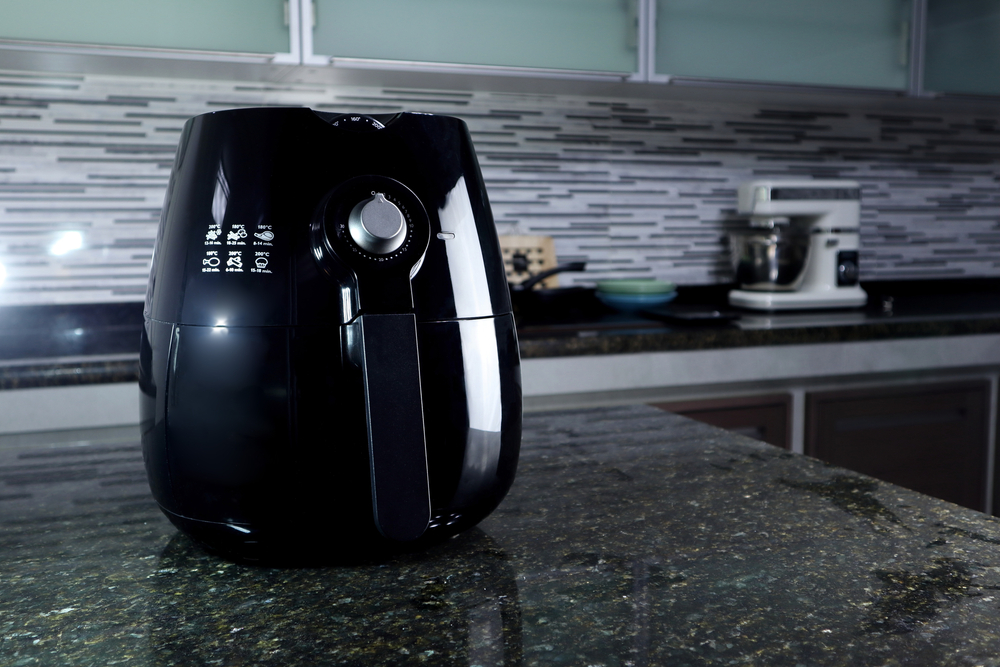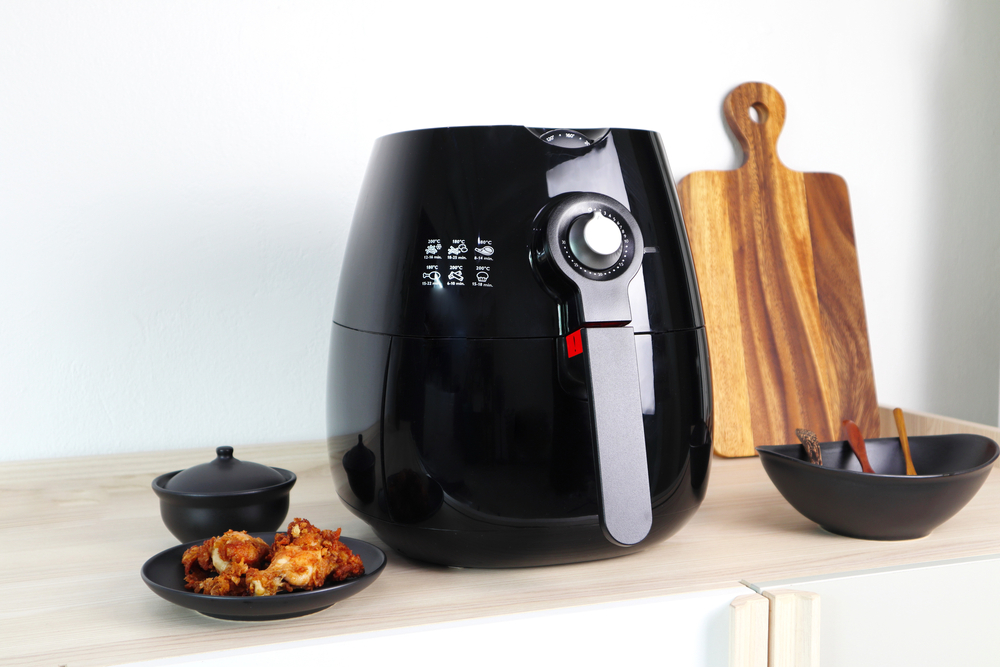Many people enjoy fried food like french fries and fried chicken, but the adverse health effects of deep-frying have increased the popularity of air frying - a healthier cooking option. Although you can use oil in an air fryer, the air fry method of cooking works in the same manner that a convection oven cooks food: through the hot air circulation.
This allows air fryers and convection ovens to reduce overall cooking time when compared to a conventional oven. Cooking food in this manner also results in crispier, more evenly heated food.

With the Right Precautions on the Right Countertop Material (or Insulation Buffer), Air Fryers Should do Just Fine
But if you’re considering where to put a potential new air fryer, you might wonder where to store this kitchen appliance safely.
So can you use your air fryer on countertops? This article will answer this question using several critical considerations. This article will also address other related questions about using air fryers in your kitchen.
Can You Use Your Air Fryer on Countertops? Toaster ovens typically reside on countertops, so it probably isn't surprising that using an air fryer on most modern countertops is perfectly fine. However, the specific answer to this question may depend on:
When deciding whether or not to use your air fryer on a countertop, there are a few other factors you might want to consider.

While This Happy Couple is Having the Time of Their Lives With Their Air Fryer, a Wider Countertop That is Made of Stone or Marble Would Be a Better Choice
How Often You Use Your Air Fryer
If you only plan on using your air fryer every once in a while, it might be worth the trouble to find another storage spot for it.
That way, you can take it out and make room for it when you need it while saving countertop space for other kitchen appliances like your microwave, instant pot, and toaster oven.
However, if you think you’ll be using your air fryer multiple times a week, it might be worth keeping your air fryer out on the countertop for quick and convenient access.
If you have a high-quality countertop with a heat-resistant surface, such as a granite countertop, you probably don’t have to worry about using your air fryer on it.
However, if you have a lower quality countertop, the heat from the air fryer could potentially damage the surface.
In this case, it might be best to use an air fryer rack or heat-resistant placemat as a buffer between your countertop and the air fryer.
Countertop materials that you should never use air fryers on include:
It is common for countertops to crack from the heat of an air fyer. Conducting a search on YouTube produces many videos of homeowners who claim that their air fryer cracked their countertops.
If you already have a lot of appliances on your countertop, you might want to store your air fryer elsewhere to prevent overcrowding.
You might also want to consider how often you’ll be using each appliance.
If you have a small countertop, you might want to choose another placement option for your air fryer so that you can free up some space.

A Wood Countertop is Not the Best Place to Put Kitchen Appliances that Emit a Lot of Heat
If you have a larger countertop, on the other hand, you might want to take advantage of the extra space and keep your air fryer out so that it’s easily accessible.
The location of your countertop might affect your decision of whether or not to use your air fryer on it.
For example, if your countertop is near a gas stove, you might want to store your air fryer elsewhere to avoid any potential accidents.
On the other hand, if your countertop is in a convenient spot that’s easy to access, with lots of clearance on all sides, you might want to keep your air fryer there.
Regardless of whether or not you choose to use your air fryer on a countertop or elsewhere, here are a few key things to keep in mind.
Additionally, it’s crucial to understand the need for proper ventilation. Air fryers typically have fans that help circulate hot air to heat the food within them. This cooking process tends to produce some smoke and grease.
Given this, it’s important to use the air fryer in a spacious, well-ventilated place. The benefits of this are two-fold: it prevents the smoke detector from going off and helps prolong your air fryer’s lifespan.
In general, it’s best to use your air fryer in an open area, near a window, or outdoors.
When selecting an appropriate spot for your air fryer, it’s helpful to choose one that’s easily accessible. Easy access is beneficial if you’re going to be using your air fryer frequently. This way, you’re not struggling to find, reach, and use it for cooking.
Another vital consideration is choosing a location away from flammable materials.
It’s important to use your air fryer in a safe place where there’s nothing around that can easily catch on fire.
So, make sure to keep your air fryer away from flammable fabrics and materials like:
Another critical factor to consider is to choose a location away from young children and pets. This consideration is important because air fryers can get very hot, both on the outside and inside.
If a child or pet were to accidentally touch the air fryer while it’s in use, they could get seriously injured.
So, make sure to keep your air fryer in a spot where children and pets can’t easily reach it or touch it.
Finally, the stability of your chosen air fryer location is essential.
When hot, air fryers can produce a lot of steam. If the location of your air fryer isn’t stable, this steam could easily cause the air fryer to tip over, which would be a considerable safety hazard.
So, make sure that the location you choose can support the weight of your air fryer and that it won’t tip over easily.
The kitchen countertop is the most common place people use and store their air fryers. However, some people also choose these other locations.
Kitchen islands are typically easily accessible, sturdy, and convenient. Plus, some people find it entertaining to watch an air fryer in action, and an island provides a great view.
A table might be a good option if you want to save countertop space or have a smaller kitchen. But you’ll need to consider how sturdy the table, how heavy the air fryer is as well as the surface of the table. You’ll likely want to have a heat resistant mat between the air fryer and a table.
Keeping your air fryer in a cabinet can save even more countertop space. Just make sure the cabinet is big enough to fit your air fryer and that it’s not too difficult to take it in and out.
This option might work if you have a limited countertop and storage space. Just ensure the area around your air fryer is clean and the cord won’t be in the way.
Keeping it on the floor is also not the best option if you have young children or pets in the home.
You may have some additional questions related to air fryers, such as the ones below.
Putting an air fryer under cabinets is generally not recommended because it can be a fire hazard.
If you choose to put your air fryer under or inside a cabinet, ensure the area is spacious enough for ventilation, at least 10 inches on all sides. Also, check that the material of the cabinet is heat-resistant.
If you don’t have counter space, another option is to put your air fryer on top of an oven or stove. However, this has potential risks if you accidentally turn on the stove.
You can also put your air fryer on an island, a cabinet, or a nearby table. If need be, you can even use your air fryer on the floor, as long as there is a heat-resistant buffer between the fryer and the floor, such as an aluminum rack.
Avoid using an air fryer that is directly up against the wall. An air fryer should have around 10 inches of clearance on all sides to ensure proper ventilation.
Putting the air fryer too close to the wall could cause smoke and grease to build up, which could be a fire hazard.
Air fryers use convective heat transfer to cook food, meaning hot air circulates around the food in the air fryer basket and heats the food.
If an air fryer doesn’t have enough space, the hot air won’t be able to circulate properly, and the food won’t cook evenly.
It also is a safety issue. If an air fryer doesn't have enough space, it can cause smoke and grease to build up, which could be a fire hazard.
Granite is a high-quality, heat-resistant material, so an air fryer shouldn’t damage your granite countertop.
However, air fryers damage countertops that have a lower quality sealant that cannot withstand the air fryer’s heat.
If you’re not certain about the quality of your countertop’s sealant, it’s best to err on the side of caution and use a heat-resistant pad or mat under your air fryer.
You can place a heat-resistant pad or mat under your air fryer to protect your countertop from the heat.
You can also use an aluminum rack to elevate your air fryer and promote proper circulation.
Although quartz is technically heat-resistant, it is not heat-proof.
Thus, to be safe, you shouldn’t use an air fryer directly on a quartz countertop because the heat can cause the quartz to crack. This risk is especially relevant if you’re using your air fryer consistently.
The most heat-resistant countertop material is granite.
Granite is a natural stone with top-notch heat resistance. This material can withstand temperatures of up to 480 Fahrenheit.
Therefore, you should be safe placing an air fryer, as well as pots, pans, and other hot cooking appliances, directly on a granite countertop.
Marble and quartz are also heat-resistant, but you must be a bit more careful with long-term heat application on these natural stones.
The least heat-resistant countertop material is laminate.
Laminate is a synthetic material that consists of multiple layers of paper or plastic, which makes it vulnerable to heat.
If you place a hot pot, pan, or appliance on a laminate countertop, it’s likely to cause the laminate to deform, discolor, or even melt.
For these reasons, you should never use an air fryer directly on a laminate countertop.
